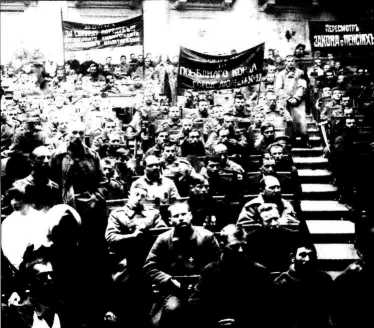
Democracy in action: soldiers’ soviet in Petrograd 1917
Publications Index | Encyclopedia of Trotskyism | Marxists’s Internet Archive
Socialist Review Index (1993–1996) | Socialist Review 180 Contents
From Socialist Review, No. 180, November 1994.
Copyright © Socialist Review.
Copied with thanks from the Socialist Review Archive.
Marked up by Einde O’Callaghan for ETOL.
The Russian Century
Brian Moynahan
Chatto and Windus £30

Democracy in action: soldiers’ soviet in Petrograd 1917 |
Illustrated histories are fascinating documents. The pictures tell a story with an economy and clarity which words may lack. Indeed, the impact of certain images helps to define our response to many of this century’s major events. However, in a period so thoroughly chronicled by photographers Russia has preserved its anonymity. The visual record, particularly in Russia’s revolutionary phase, seems disappointingly sparse.
It is the great virtue of The Russian Century that it has lifted the veil a little and revealed some amazing sights from Russia’s past. These are not the fanciful images of Stalin’s myth factory, but the frank and sometimes brutal images of a country in turmoil.
The first part of the book is best, where the photos tap into the vigour and enthusiasm of Russia’s revolutionary currents. Mutinous soldiers race around Petrograd in commandeered vehicles, flags flying, bayonets fixed. Trotsky addresses a mass demonstration from a podium improvised out of park benches. The soldiers’ section of the Petrograd soviet sits in packed session, each face radiating determination and courage. These dynamic pictures capture the optimism generated by such great events. Viewed together with the haunting images from earlier in the book, which portray workers’ lives under Tsarism, we gain valuable insights into the process which transforms repression into revolt.
The pity is that such remarkable pictures illustrate such an awful text. The author is a right wing journalist and a mediocre historian. This qualifies him to, at best, describe events but not to understand them. He is reduced to merely recycling various tired clichés about Russia.
Moynahan’s violent anti-socialism creates a glaring contradiction in the early part of the book where the accumulated weight of photographic evidence paints a very different picture from the version of events presented by the author.
There is no sense here of Russia as part of a global system, of a revolutionary regime being strangled by its isolation and succumbing to the logic of a world capitalist system. There are many good books on Russian history and the October Revolution but this isn’t one of them. It is to be hoped that as the photographic archives in Russia open up a better illustrated history will be forthcoming than this wasted opportunity.
Socialist Review Index | ETOL Main Page
Last updated: 5 November 2017